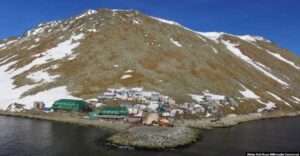
WASHINGTON — Last month, Native Alaskans on Little Diomede Island awoke to see their city office collapsing into the community school next door.
For the Ingalikmiut people [Inupiat] in the Bering Strait, halfway between Siberia and the Alaska mainland, this was the latest crushing evidence of the impact of climate change in the Arctic.
“Looking at the timber and the wood timbers [stilts] that had supported the office building, we didn’t find them to be deteriorating,” explained Sean McKnight, who was part of an inspection team from the Nome-based tribal consortium Kawerak Inc. “Basically, the permafrost is degrading, so building foundations are sinking and sliding.”
Inspectors discovered that several other buildings have also begun to shift downhill.
“Our opinion is that this is going to affect every building in Diomede,” McKnight said.
So, how will Diomeders cope?
“These people have been living here for thousands of years,” McKnight told VOA. “They’re adaptive. They’re resourceful. When they have a problem, they just fix it. This is their home. They have no choice.”
Living on stilts
The city of Diomede, population about 86, consists of three dozen buildings on stilts on the lower slope of an almost vertical cliff. There is a washeteria, where residents shower and do laundry, a health clinic, a small store and a helipad.
In past winters, community members used bulldozers to carve a runway into the ice offshore. This allowed planes to deliver food and supplies. Today, the ice offshore is all new — that is, ice that has not been able to survive a summer melt season.
“The last time we had an ice runway for essential air service was 2014, and that was only for two weeks I believe,” says Diomede tribal coordinator Frances “Sistuq” Ozenna. “Today, we have chopper services year-round. They fly passengers on Mondays, and on Wednesdays, they do mail runs. But the weather always interferes.”
And that can lead to critical shortages of food, medicine and supplies.
“You have to reserve as much as you can, just in case it takes a while for us to get any services to Diomede,” Ozenna told VOA.
That means the tribe must rely more on traditional methods of subsistence, harvesting wild greens, berries or potatoes in spring and seasonal hunting of migrating marine mammals, including walrus and seals.
If the ice is thick enough to cross, that is.
“Food security for Diomede, I think it’s always going to be an issue, because we have limitations in transportation and hunting equipment,” Ozenna says. “You have to know how to survive Diomede. It can get pretty frustrating.”
Undercover predators
In recent years, climate change has introduced a new threat to Diomeders: polar bears, the largest land carnivores on Earth.
Unlike other bear species, polar bears do not hibernate in winter but travel far with the ice in search of seals. Normally at this time of year, they would be far out on the ice, away from human settlements.
But as their habitat melts, they can end up stranded on land.
“You never know when they’re going to come in,” Ozenna said. “They’re most likely to come in at nighttime or during a blizzard, when things are obscured.”
School children are particularly vulnerable, which is why Diomede men will get up early, grab their rifles and patrol the streets, on the lookout for hungry bears.
Diomeder Brendon Ozenna captured this video of a polar bear and her cub attempting to access the community school on November 5, 2021.
After the buildings collapsed, Alaska Governor Mike Dunleavy issued a disaster declaration for Diomede that makes state resources available to help rebuild the city office.
For now, the school’s 22 students have switched to distance learning until after the Christmas holidays.
This, it would seem, is a blessing in disguise — over the past two weeks alone, Ozenna says she has seen three polar bears lurking around town looking for their next meal.
More than 1,000 kilometers northeast of Diomede on Alaska’s northern coast, VOA’s Natasha Mozgovaya reports on permafrost and polar bears in the city of Kaktovik.
